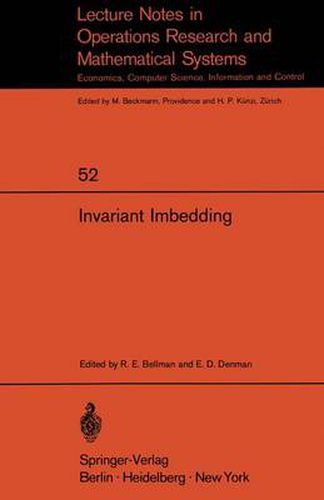Readings Newsletter
Become a Readings Member to make your shopping experience even easier.
Sign in or sign up for free!
You’re not far away from qualifying for FREE standard shipping within Australia
You’ve qualified for FREE standard shipping within Australia
The cart is loading…






This title is printed to order. This book may have been self-published. If so, we cannot guarantee the quality of the content. In the main most books will have gone through the editing process however some may not. We therefore suggest that you be aware of this before ordering this book. If in doubt check either the author or publisher’s details as we are unable to accept any returns unless they are faulty. Please contact us if you have any questions.
Imbedding is a powerful and versatile tool for problem solving. Rather than treat a question in isolation, we view it as a member of a family of related problems. Each member then becomes a stepping stone in a path to a simultaneous solution of the entire set of problems. As might be expected, there are many ways of accomplishing this imbedding. Time and space variables have been widely employed in the past, while modern approaches combine these structural features with others less immediate. Why should one search for alternate imbeddings when elegant classical formalisms already exist? There are many reasons. To begin with, different imbeddings are useful for different purposes. Some are well suited to the derivation of existence and uniqueness theorems, some to the derivation of conservation relations, some to perturbation techniques and sensitivity analysis, some to computa tional studies. The digital computer is designed for initial value problems; the analog computer for boundary-value problems. It is essential then to be flexible and possess the ability to use one device or the other, or both. In economics, engineering, biology and physics, some pro cesses lend themselves more easily to one type of imbedding rather than another. Thus, for example, stochastic decision processes are well adapted to dynamic programming. In any case, to go hunting in the wilds of the scientific world armed with only one arrow in one’s quiver is quite foolhardy.
$9.00 standard shipping within Australia
FREE standard shipping within Australia for orders over $100.00
Express & International shipping calculated at checkout
This title is printed to order. This book may have been self-published. If so, we cannot guarantee the quality of the content. In the main most books will have gone through the editing process however some may not. We therefore suggest that you be aware of this before ordering this book. If in doubt check either the author or publisher’s details as we are unable to accept any returns unless they are faulty. Please contact us if you have any questions.
Imbedding is a powerful and versatile tool for problem solving. Rather than treat a question in isolation, we view it as a member of a family of related problems. Each member then becomes a stepping stone in a path to a simultaneous solution of the entire set of problems. As might be expected, there are many ways of accomplishing this imbedding. Time and space variables have been widely employed in the past, while modern approaches combine these structural features with others less immediate. Why should one search for alternate imbeddings when elegant classical formalisms already exist? There are many reasons. To begin with, different imbeddings are useful for different purposes. Some are well suited to the derivation of existence and uniqueness theorems, some to the derivation of conservation relations, some to perturbation techniques and sensitivity analysis, some to computa tional studies. The digital computer is designed for initial value problems; the analog computer for boundary-value problems. It is essential then to be flexible and possess the ability to use one device or the other, or both. In economics, engineering, biology and physics, some pro cesses lend themselves more easily to one type of imbedding rather than another. Thus, for example, stochastic decision processes are well adapted to dynamic programming. In any case, to go hunting in the wilds of the scientific world armed with only one arrow in one’s quiver is quite foolhardy.